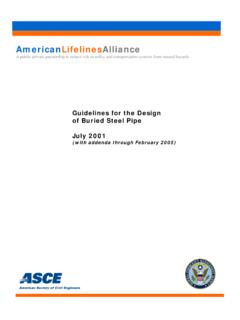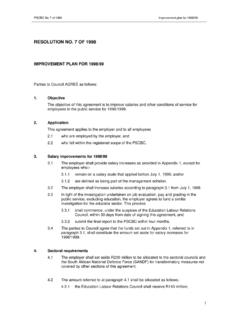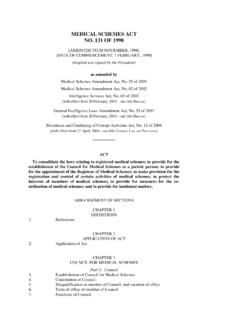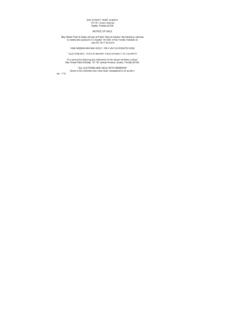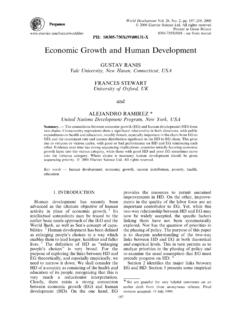Transcription of Guidelines for the Design of Buried Steel Pipe July …
1 AmericanLifelinesAlliance A public-private partnership to reduce risk to utility and transportation systems from natural hazards Guidelines for the Design of Buried Steel pipe july 2001 (with addenda through February 2005) A public-private partnership to reduce risk to utility and transportation systems from natural hazards This report was written under contract to the American Lifelines Alliance, a public-private partnership between the Federal Emergency Management Agency (FEMA) and the American Society of Civil Engineers (ASCE). This report was reviewed by a team representing practicing engineers and for the Design of Buried Steel pipe july 2001 i Acknowledgments The following people (with their affiliations) contributed to this report.
2 G. A. Antaki, Co-chairman WSRC, Aiken, SC J. D. Hart, Co-chairman SSD, Inc., Reno, NV T. M. Adams Stevenson and Associates, Cleveland, OH C. Chern Bechtel, San Francisco, CA C. C. Costantino City College of New York, New York, NY R. W. Gailing Southern California Gas Co., Los Angeles, CA E. C. Goodling Parsons Energy & Chemicals, Reading, PA A. Gupta North Carolina State University, Raleigh, NC R. Haupt Pressure Piping Engineering, Foster City, CA A. P. Moser Utah State University, Logan, UT M. O Rourke Rensselaer Polytechnic Institute, Troy, NY S. Peterson Lakehead pipe Line Co., Bay City, MI M. Rosenfeld Kiefner & Associates, Worthington, OH J. E. Thomas S/D Engineers, Pittsburgh, PAGuidelines for the Design of Buried Steel pipe july 2001 ii Table of Contents Introduction.
3 1 Project Objective ..1 Cautions ..2 Notations ..3 Internal Pressure ..9 Sources of Internal Pressure ..9 Example ..9 Vertical Earth Load ..10 Applied Load ..10 Deflection and Stress Under Soil Example 1 ..11 Example 2 ..11 Example 3 ..11 Figure ..12 Surface Live Loads ..13 Applied Ovality and Stress ..15 Ovality ..15 Through-Wall Crushing of Side Walls ..16 Ring Buckling ..16 Fatigue ..17 Example ..17 Figures ..19 Surface Impact Maximum Impact Load ..21 Penetration and PPV ..21 Example ..22 Figure ..23 Applied Load ..24 pipe Stress ..24 Example ..25 Thermal Expansion Loads and Stresses ..27 Example.
4 27 Figure ..28 Guidelines for the Design of Buried Steel pipe Applied Load .. 29 29 Example .. 30 Figures .. 32 Movement at pipe Bends .. 41 pipe 41 41 Figure .. 42 Mine Subsidence .. 43 Earthquake .. 44 Seismic Wave Propagation .. 44 Permanent Ground Displacement .. 45 Example .. 46 Figures .. 48 Effects of Nearby Blasting .. 50 Applied Stress .. 50 52 Example .. 52 Figure .. 54 Fluid 55 Applied 55 56 Example .. 56 In-Service Relocation .. 58 Applied Load .. 58 59 Example .. 60 Figures .. 61 References and 62 Appendix A: Suggested Acceptance Criteria .. 66 Appendix B: Soil Spring Representation .. 68 Axial Soil 68 Lateral Soil 69 Vertical Uplift Soil Springs .. 70 Vertical Bearing Soil 71 71 72 Guidelines for the Design of Buried Steel pipe july 2001 iv List of Figures Figure Soil Prism Above Figure Surface Load and Transmitted Figure Ovality of pipe Cross Figure Through-Wall Bending Stress.
5 20 Figure Crushing of Side Figure Ring Buckling of pipe Cross Figure Fall of a Heavy Object on Ground Figure Resultant Buoyancy Load on pipe ..26 Figure Distributed Buoyancy Load on pipe ..26 Figure Bending Moment at Buried pipe Bend Due to Constrained pipe Expansion ..28 Figure Pipeline Thaw Settlement Scenario ..32 Figure Finite Element Model of Pipeline Figure Buried Pipeline Subject to Vertical Fault Figure (a) Vertical Displacement Profile Along the Pipeline ..35 Figure (b) Axial Displacement Profile Along the Figure (c) Axial Force Profile Along the Pipeline ..36 Figure (d) Bending Moment Diagram Along the Figure (a) Top Fiber Axial Strain Diagram Along the Pipeline ..37 Figure (b) Bottom Fiber Axial Strain Diagram Along the Pipeline.
6 37 Figure (c) pipe Curvature Diagram Along the Figure (d) pipe Rotation Diagram Along the Pipeline ..38 Figure (a) Force in Longitudinal Soil Springs Along the Pipeline ..39 Figure (b) Displacement in Longitudinal Soil Springs Along the Pipeline ..39 Figure (c) Force in Transverse Soil Springs Along the Pipeline ..40 Figure (d) Displacement in Transverse Soil Springs Along the Figure Model of Figure Direction of Ground Movement and Zones of pipe Axial Tension and Compression for Longitudinal PGD where L is Small to Figure Direction of Ground Movement and Zones of pipe Axial Tension and Compression for Longitudinal PGD where the Length of the PGD Zone is Large ..48 Figure Transverse PGD With Spatial Extend W and Amount of ..49 Figure Pipeline Lowering with Transition Lengths Figure Pipeline Lowering with Transition Lengths L1 and Obstruction Length L2.
7 61 Figure Pipeline Modeling Approach ..72 Figure Plotted Values for the Adhesion Factor, ..73 Figure Values of Nqh and Nch of Hansen 1961 ..74 Figure Ranges for Values of Nqv and Ncv (from Trautman and O Rourke, 1983)..75 Figure Plotted Values of Bearing Capacity Factors (Nq, Nc, and N )..76 Guidelines for the Design of Buried Steel pipe july 2001 v List of Tables Table Live Loads ..13 Table Impact Factor (F ) versus Height of Cover ..14 Table Soil Resistance Properties for Example Problem ..31 Table Peak Ground Velocity ..45 Table Empirical Coefficients for Estimating Velocity and Stress ..51 Table Normalization Factors for Common Types of Explosives ..51 Table Friction factor f for Various External Guidelines for the Design of Buried Steel pipe july 2001 Page 1 Introduction The American Lifelines Alliance (ALA) was formed in 1998 under a cooperative agreement between the American Society of Civil Engineers (ASCE) and the Federal Emergency Management Agency (FEMA).
8 In 1999, ALA requested a group of civil and mechanical engineers, listed in the Acknowledgements, to prepare a guide for the Design of Buried Steel pipe . The group prepared the Guidelines presented in this report, with an emphasis on the fundamental Design equations suitable for hand calculations, and where necessary, guidance for finite element analysis. Project Objective The purpose of this guide is to develop Design provisions to evaluate the integrity of Buried pipe for a range of applied loads. The provisions contained in this guide apply to the following kinds of Buried pipe : New or existing Buried pipe , made of carbon or alloy Steel , fabricated to ASTM or API material specifications. Welded pipe , joined by welding techniques permitted by the ASME code or the API standards.
9 Piping designed, fabricated, inspected and tested in accordance with an ASME B31 pressure piping code. These codes are: power piping, process piping, liquid hydrocarbon pipelines, refrigeration piping, gas transmission and distribution piping, building services piping, slurry piping, and ASME Boiler and Pressure Vessel Code, Section III, Division 1 nuclear power plant piping. Buried pipe and its interface with buildings and equipment. Each section in the guide addresses a different form of applied load: Internal Pressure Vertical Earth Loads Surface Live Loads Surface Impact Loads Buoyancy Thermal Expansion Relative pipe -Soil Displacement Movement at pipe Bends Mine Subsidence Earthquake Effects of Nearby Blasting Guidelines for the Design of Buried Steel pipe july 2001 Page 2 Fluid Transients In-Service Relocation A dimensionally consistent set of units is used throughout, unless units are specifically called out.
10 For typical pressure piping applications, the pipe demand calculations for some of these load conditions can lead to inconsequential stress levels. Nevertheless, the procedures for estimating pipe stress demands due to these loads are presented for completeness. As designers gain experience using these calculations, they will more efficiently identify which load conditions are relevant to their particular application. Examples of calculations for computing various measures of demand on Buried pipes are presented at the end of each section, whenever possible. The designer should appropriately combine the effects of concurrent loads when evaluating the adequacy of the Buried pipe . Appendix A: Suggested Acceptance Criteria contains guidance for the evaluation of the Buried pipe capacity.
